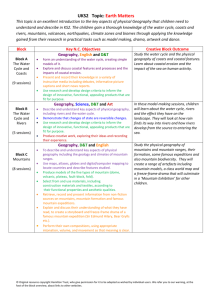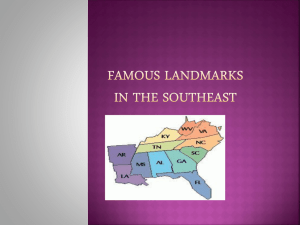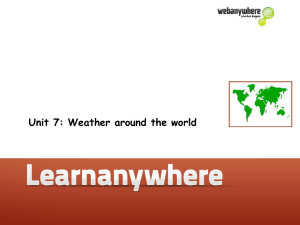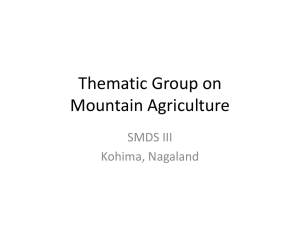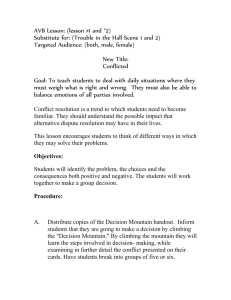Geography - Lewiston Independent School District #1
advertisement
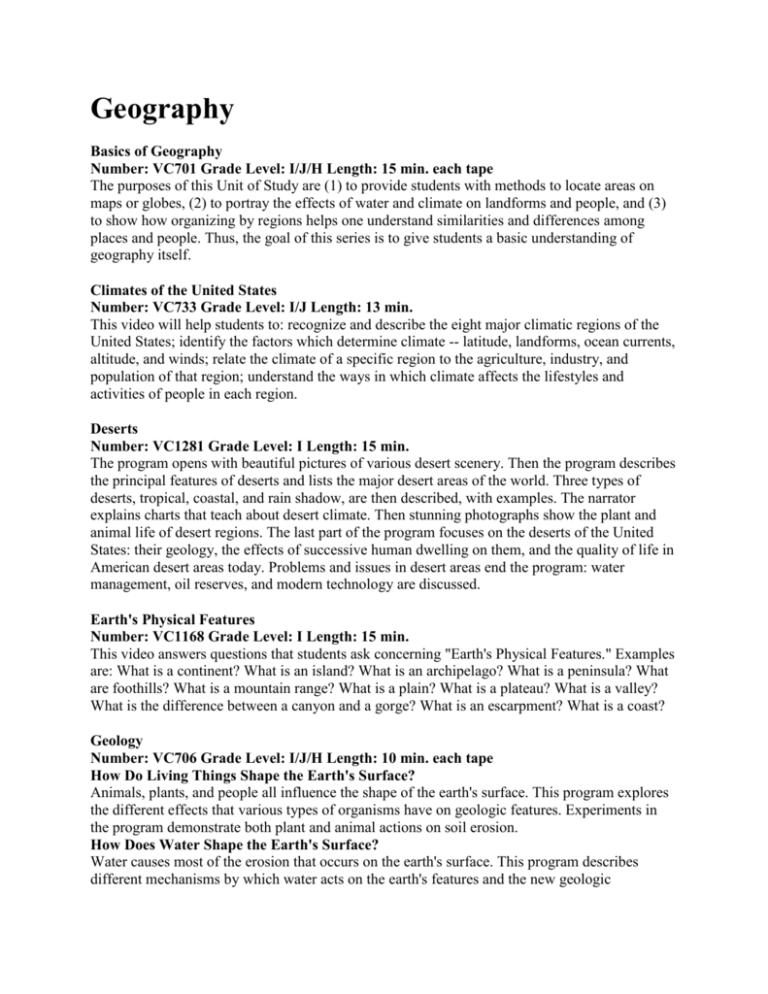
Geography Basics of Geography Number: VC701 Grade Level: I/J/H Length: 15 min. each tape The purposes of this Unit of Study are (1) to provide students with methods to locate areas on maps or globes, (2) to portray the effects of water and climate on landforms and people, and (3) to show how organizing by regions helps one understand similarities and differences among places and people. Thus, the goal of this series is to give students a basic understanding of geography itself. Climates of the United States Number: VC733 Grade Level: I/J Length: 13 min. This video will help students to: recognize and describe the eight major climatic regions of the United States; identify the factors which determine climate -- latitude, landforms, ocean currents, altitude, and winds; relate the climate of a specific region to the agriculture, industry, and population of that region; understand the ways in which climate affects the lifestyles and activities of people in each region. Deserts Number: VC1281 Grade Level: I Length: 15 min. The program opens with beautiful pictures of various desert scenery. Then the program describes the principal features of deserts and lists the major desert areas of the world. Three types of deserts, tropical, coastal, and rain shadow, are then described, with examples. The narrator explains charts that teach about desert climate. Then stunning photographs show the plant and animal life of desert regions. The last part of the program focuses on the deserts of the United States: their geology, the effects of successive human dwelling on them, and the quality of life in American desert areas today. Problems and issues in desert areas end the program: water management, oil reserves, and modern technology are discussed. Earth's Physical Features Number: VC1168 Grade Level: I Length: 15 min. This video answers questions that students ask concerning "Earth's Physical Features." Examples are: What is a continent? What is an island? What is an archipelago? What is a peninsula? What are foothills? What is a mountain range? What is a plain? What is a plateau? What is a valley? What is the difference between a canyon and a gorge? What is an escarpment? What is a coast? Geology Number: VC706 Grade Level: I/J/H Length: 10 min. each tape How Do Living Things Shape the Earth's Surface? Animals, plants, and people all influence the shape of the earth's surface. This program explores the different effects that various types of organisms have on geologic features. Experiments in the program demonstrate both plant and animal actions on soil erosion. How Does Water Shape the Earth's Surface? Water causes most of the erosion that occurs on the earth's surface. This program describes different mechanisms by which water acts on the earth's features and the new geologic formations that arise because of these mechanisms. The experiments shown explore the effects of running water on sediment and the force of water's expansion as it freezes. Glacial action is also explained, as are the problems resulting from the interference of sediment with waterways. How Does Wind Shape the Earth's Surface? This program explores the two fairly inconspicuous types of erosion work as well as the geologic features that create these erosive forces. Also discussed in the program is the loss of topsoil from farms due to wind transport. What Are the Different Shapes on the Earth's Surface? The earth's surface varies from region to region. However, there are only three basic types of landforms: mountains, plateaus, and plains. This program introduces these basic landforms as well as the principles of topographic maps and how to use them. Grand Canyon Number: VC339 Grade Level: I/J/H Length: 29 min. This dramatic presentation of Ferde Grofe's "Grand Canyon Suite" is a marvelous blend of nature photography and music in a salute to a natural wonder. Grand Canyon Mule Ride Number: VC779 Grade Level: P/I/J/H Length: 40 min. Climb aboard...from early morning round up, to the head wrangler's memorable talk on how to ride a mule, to steak dinner served family style at Phantom Ranch...experience the Grand Canyon like you never have before. Grand Canyon, Petrified Forest, & Painted Desert Number: VC609 Grade Level: P/I/J/H Length: 45 min. Come discover the wonderful worlds of the Grand Canyon, Petrified Forest and Painted Desert. Learn the geological mysteries of each park, uncovering the unique natural processes which created them. Grasslands Number: VC1282 Grade Level: I Length: 14 min. The program opens with scenes from grasslands around the world. The narrator then defines grasslands and divides them into categories: savannas (tropical grasslands), steppes, and prairies. Next the program presents beautiful photographs of the animal and plant life in the grasslands of Africa and North America. The program then reviews the history of the North American Great Plains, from the era when bison and other grazing animals ruled the plains, to the civilization of the Indians, the arrival of explorers and settlers, to today's modern agriculture. General trends in economics and industry are reviewed. The American farm experience is then compared to others, such as the sheep ranches of Australia and the game preserves of East Africa, in terms of land and animal management in the grasslands. The program ends by emphasizing what all grassland Great American Desert Number: VC472 Grade Level; I/J/H Length: 16 min. The objectives are: locate the four North American deserts and identify their distinguishing characteristic, and account for the growth of mining towns, and their transformation into ghost towns, and appreciate the significance of the Colorado river to this region and become aware of the controversy over the division of its waters. Great Geography! Number: VC1645 Grade Level: I Length: 41 min. Lively young hosts present all the basics of geography: latitude, longitude, the equator, the international date line, continents, oceans, rivers, map symbols , and much more. Students discover that geography is a fascinating subject. Colorful graphics and funny skits make this a perfect introduction. Horn of Africa - Somalia & Djibouti Number: VC967 Grade Level: I/J/H Length: 20 min. The countries of Somalia, Djibouti, and parts of Ethiopia make up the desolate land of the Horn of Africa. the Horn of Africa has always been a critical region of Africa due to its strategic location for commerce conducted through shipping. This program explores these countries that make up the Horn of Africa, and compares and contrasts them in terms of their economy, culture, politics, and geography. Neighboring Arab countries also greatly influence all aspects of life in this region to the point where Islam is the predominant religion. Viewers will see how this influence, as well as the lingering influence of former European Colonization, affects life in the Horn of Africa. Idaho High Country 1961 Number: VC886 Grade Level: P/I/J/H Length: 15 min. Mountain Home, an entrance to Idaho high country, a trail back into the mountain fastnesses, a unique route to Idaho's Sawtooth Mountains is illustrated with maps being drawn. Trinity Mountain, Rocky Bar, the Lazy H Ranch, Alturas lake, Redfish lake, and the lake of lakes under Gun Sight Peak, Stanley Lake. Junior Geologist Number: VC907 Grade Level: P/I Length: 9 min. each videotape The materials in this program were developed to achieve the following goals: Introduce students to the science of geology and the work of a geologist. Describe earth's structure. Discusses the different forces that cause land to build up. Discusses the eroding power of water, wind, ice, and gravity that wear the earth down. Explains the origins of rocks and minerals. Let's Make a Map Number: VC1259 Grade Level: P Length: 11 min. By reducing a street and its buildings to a cardboard model, then to wooden blocks, then to pieces of cloth, this step-by-step presentation show how the three-dimensional world is reduced to abstract lines on a flat surface. Map: Earth's Picture Number: VC955 Grade Level: P Length: 6 min. This video explains how aerial photographs are used to make maps. It also describes the different symbols that are used in the map key. Map and Globe Terms Number: VC1122 Grade Level: I Length: 15 min. This video answers questions that students ask concerning "Map and Globe Terms." Examples are: What are maps and globes? What is longitude? Why are lines of latitude called parallels? What are meridians? What is a grid? What is a pole? What are great circle routes? Why are there different types of map projections? Why is the globe the best representation of the Earth? What is a legend? What does a map symbol stand for? Map Skills Number: VC1124 Grade Level: I Length: 15 min. This video answers questions that students ask concerning "Map Skills." Examples are: How do you determine directions on a map? How does scale vary from map to map? What does the scale ratio noted on maps mean? How do you plot latitude and longitude on a map? How are colors used on maps? What are some common symbols used on a political map? What are some important features on a road or highway map? What symbols are used on city maps? Map Skills Series: Latitude Number: VC370 Grade Level: I/J Length: 17 min. The exploits of animated wildlife photographer Natalie Haymaker teach students how all points north and south of the equator are measured in degrees, why there is a definite worldwide relationship between latitude and climate, how degrees translate into miles, and how, in the northern hemisphere, latitude can be calculated in reference to the North Star. Map Skills Series: Longitude Number: VC378 Grade Level: I/J Length: 16 min. Animation demonstrates the location and role of the prime meridian, measurement of longitude in degrees, time, and miles, how longitude meridians are used to divide the globe into time zones, and how the distance between longitude lines get shorter away from the equator. Map Skills Series: Physical Features Number: VC406 Grade Level: I/J Length: 12 min. When outdoorsman Lance Bolder attempts to climb the highest mountain on the island, he learns some important lessons about how a map indicates physical features. Viewers are introduced to map indicators for various bodies of water, including the difference between a gulf, a bay, a lake and an ocean. As Lance reaches a plateau and a mountain, viewers are shown how to read a map to determine elevation above sea and land contour. Map Skills Series: Using Maps Together Number: VC473 Grade Level: I/J Length: 12 min. Different maps are made to provide specific information; but no single map explains everything about an area. Lance Bolder shows viewers how to use information from several maps of the same scale to reveal information about a single area. This program emphasizes the value of combining information from elevation maps, transportation maps, physical feature maps, rainfall maps and natural resource maps. It also underscores the meaning and significance of colors, lines, and symbols on maps. Map Skills Series: Using Scale Number: VC424 Grade Level: I/J Length: 12 min. The concept of scale is compared to actual objects and illustrated through ratio, unit comparison, and bar scale; scale is then applied to measuring distances over a winding or varied terrain. Maps: Where Am I? Number: VC1195 Grade Level: P Length: 11 min. It's hard for kids to relate the three-dimensional, horizon-oriented world they live in to the twodimensional, vertically oriented "world" of maps. This video will help to solve that problem. The Mid-Atlantic States Number: VC1289 Grade Level: I Length: 16 min. The program begins with a scenic overview of the Mid-Atlantic Region. Maps then locate the region within the United States, locate the key waterways--especially bays--of the region, and locate key cities. The narrator describes how natural bays and harbors led to development of cities along the coast. The script then surveys some major Mid-Atlantic cities: New York, Philadelphia, Baltimore, and Washington DC. But the Mid-Atlantic Region contains many rural areas as well. The script surveys the three major landforms of the region--the Coastal Plain, the Appalachians, and the Piedmont--showing the variety of agriculture, fishing, mining, and other occupations outside the area of the eastern "megalopolis." A city in the west of the region, Pittsburgh, is also visited. More maps show the climate of the region. The program ends with more of the region's varied scenery, urban and rural. The Middle and Northern Forests Number: VC1284 Grade Level: I Length: 14 min. The program begins with pictures from the forests of North America, and Soviet Union, and Europe. The narrator then describes and compares the middle-latitude forests and the northern forests, locating each type of forest on the map and describing its climate and dominate tree species. Next the program shows some of the wildlife of the northern and middle-latitude forests. The history of the forests of eastern North America serves as an example of how human settlement affects the forest. The forests of the Soviet Union and Canada are described for comparison. The program ends by listing some of the benefits of the northern forests for modern life and some of the challenges facing us in our use of forest resources. Mount Rainier: What is a Mountain Number: VC108 Grade Level: I/J/H Length: 30 min. This is an excellent program for teachers, students, nature enthusiasts or anyone who appreciates the special beauty of Mount Rainier National Park. The Mountain States Numbers: VC1290 Grade Level: I Length: 16 min. The program begins with scenes from the Rocky Mountains, the immense chain that unites this geographical region. With maps and diagrams, the narrator shows the major landforms, mountain ranges, basins, and deserts, and discusses how the rain shadow formed by the Rocky Mountains affects the climate of the region. The script then discusses mining, ranching, and other Mountain Region industries on which the whole nation depends. The importance of the region's wilderness areas and Indian reservations are also discussed. The water systems of the region, including huge hydroelectric dams on the Colorado and other rivers, are also covered. The region's cities, with their rich Spanish, Indian, and pioneer history are also presented. The program ends with a discussion of the growth that has come to the Mountain states in recent years, as more and more Americans are drawn to its fresh air and spectacular scenery. The Mountains Number: VC1285 Grade Level: I Length: 16 min. This program begins with a review of impressive world mountain landscapes, and then lists the major mountain regions of the world. Each mountain area is described as to its origin, its age and its major geographic features. The narrator then explains why mountain climates vary according to elevation and distance from the equator. Next the program reviews some of the plant and animal life found in mountain regions. The history of the Rocky Mountains is presented as an example of how mountain regions change in response to human use. For comparison and contrast, two other mountain regions, the Swiss Alps and the South American Andes, are discussed. The program end with an overview of some of the problems and challenges all mountain regions have in common. The New England States Number: VC1291 Grade Level: I Length: 16 min. The scenic overview at the beginning of the program shows New England's rocky coasts, mountains, villages, schools and historical sites. Maps then show how the Atlantic Ocean and the Appalachian Mountain chain unite the region. More photos and maps explain the region's climatic patterns. Pictures of the four New England seasons highlight the region's agriculture, tourist industry, fishing industry, and logging. Other industries--textiles, shoemaking, and computers--are also surveyed. The narrator then takes us on a tour of some of New England's many historic sites, concentrating on the city of Boston as exemplifying the region's unique blend of the past and the future. The North Central States Number: VC1292 Grade Level: I Length: 16 min. The program first presents the basic contrast of the North Central Region. It contains America's largest farmlands as well as many of this vast region, and outline the division of the region into states. Diagrams and photographs then demonstrate the region's dramatic geography, from the "wide open spaces" of the prairies, to the Bad Lands, to the Great Lakes. The importance of these lakes, and of the vast Mississippi/Missouri/Ohio river system are discussed. All are factors that contribute to the North Central Region's importance to national life. The history of land use in the region, from Indian times to the present agribusiness, is reviewed. Then rural life is contrasted with life and industry in big cities such as Detroit, St. Louis, and Chicago. At the end of the program, pictures show how the North Central's rural and urban areas are connected to each other and to the nation. Our Changing Earth Number: VC896 Grade Level: I/J/H Length: 20 min. After viewing the program students should understand how scientists think the Earth was formed; that the Earth is made up of different layers, including the crust, mantle, outer core, and inner core; what weathering is and some of the forces that cause it; what erosion is and what causes it; what the theory of continental drift is; what the theory of plate tectonics is; what volcanoes are; what earthquakes are. Pacific States Number: VC1293 Grade Level: I Length: 20 min. The program opens with the spectacle of the Pacific Ocean, which is the geographic feature that unites this region. Maps show where the ocean, its islands, and the coastal mountain chains are located. Maps also show the political division—states and cities. Beautiful photographs survey the region’s rocky and sandy beaches, tall mountains, large cities, and huge farmlands. The immensely varied climate of the region—from the arctic climate of Alaska to the tropical climate of Hawaii—are shown. Large-scale agriculture and, in Alaska, large-scale oil exploration, have made all the nation economically dependent on the Pacific States. The entertainment and tourist industries also draw people from everywhere in America to the Pacific Region. Physical Features: Map Skills Series Number: VC406 Grade Level: I/J Length: 12 min. Lance Bolder attempts to climb the highest mountain on the island, he learns some important lessons about how a map indicates physical features. Viewers are introduced to map indicators for various bodies of water, including the differences between a gulf, a bay, a lake and an ocean. As lance reaches a plateau and a mountain, viewers are shown how to read a map to determine elevation above sea and land contour. River Song: A Natural History of the Colorado River in Grand Canyon Number: VC894 Grade Level: I/J/H Length: 40 min. The Colorado River is the lifeblood of the Grand Canyon, yet because of its remoteness, it was not explored completely until 1869, and even today remains a challenge to the adventuresome. This video shows the animals, plants, geology, and the great river itself. Rocks and Minerals: The Hard Facts Number: VC560 & VC895 Grade Level: I/J/H Length: 20 min. We follow an Earth scientist to several rock outcrops and exposures in order to examine firsthand some of the characteristic of the rocks and minerals of the Earth's crust. The first stop is an abandoned feldspar quarry, then an outcrop of nearly horizontal beds of a sedimentary siltstone, and finally an outcrop of metamorphic rock. South Africa: A Land Apart Number: VC968 Grade Level: I /J/H Length: 20 min. A nation in transition, South Africa has gone through many turbulent times. From Dutch colonization to apartheid, to its first democratic elections, there is more to this country than just the headlines. This program explores the diverse geography, rich natural resources and remarkable game reserves, as well as the unique political changes of South Africa's past. Viewers travel to Cape Town and Johannesburg, the two largest cities in South Africa. The South Central States Number: VC1294 Grade Level: I Length: 16 min. The program opens with visuals that show some of the variety of scenery in the South Central Region. Maps then review the geographical and political features of the region. The narrator then presents two broad geographical divisions of the region: the Gulf Coastal Plain, with its agriculture, beaches, wildlife, fishing, and oil, and the Great Plains, where cattle ranching, wheat growing, and petroleum production dominate the economy. Reference is made to the need for water in part of the region, too. Next the program tours some of the cities of the region: Oklahoma City, Tulsa, Houston, New Orleans, San Antonio, Dallas, Fort Worth, Austin, Hot Springs, and Little Rock. Scenes from wilderness areas and national parks end this overview of the South Central Region. The Southeastern States Number: VC1295 Grade Level: I Length: 17 min. The program opens with beautiful photographs of the varied scenery of the Southeast. Then, with the aid of maps, the narrator describes the region's major geographical divisions, the Coastal Plains, the Piedmont, and the Appalachians, and demonstrates how the geography of these three areas affects the region's economy and industry. The region's temperate climate makes the land especially well suited to agriculture. Photographs explain the importance of farming to the region. Also included are tours of the region's history. The Southeast is presented, finally, as a region rich in farmland, water, and other natural resources, and as growing both in population and importance to national economic life. T. V. History of Idaho: Land Number: VC510 Grade Level: I/J/H Length: 55 min. This is a geological look at Idaho's land. It looks at animal fossils in southern Idaho and plant fossils in Clarkia as well as the rock formations. The Tropical Forests Number: VC1286 Grade Level: I Length: 14 min. The program opens with beautiful pictures of the lush tropical forest. Maps illustrate where the world's tropical forests are located. The reasons for the heat and humidity of equatorial forests are explained, and the general characteristics of tropical forests (high temperature and rainfall) are described. The program then describes the vegetation of tropical forests (giant buttressed trees, lianas, air plants, orchids) as well as the variety of exotic animals that live in the region. The islands of Hawaii are presented as a case study for tropical forests. The narrator tells how land use has changed, and how the Hawaiian way of life has changed as a result. The program ends with a discussion of how the opening of the tropical rain forests to industrial development is changing the forests and the lives of the people who live there. The Tundra and Arctic Number: VC1287 Grade Level: I Length: 14 min. The program begins with photographs of the Arctic region, describing its summers of continuous daylight and winters of continuous darkness. Maps then locate the Arctic and Antarctic regions. Diagrams show how the earth's tilt creates the arctic climate. The program then describes and shows the vegetation and animal life of the region. The Inuit (Eskimo) are described, as an example of how a traditional Arctic way of life is being changed in modern times. The importance of the Arctic for oil, mineral resources, and military strategy is discussed. The program ends with the peaceful contrast of the international science stations in the Antarctic. Types of Maps & Map Projections Number: VC1123 Grade Level: I Length: 15 min. This video answers questions that students ask concerning "Types of Maps & Map Projections." Examples are: What are maps? What are some common types of map projections? What is a polar map? What is a political map? What is a physical map? How is a topographical map different from a relief map? What are the main parts of a weather map? What is a climate map? What is a vegetation map? What is the difference between a product and a resource map. United States: A Geographical Overview Number: VC1288 Grade Level: I Length: 14 min. The program begins with spectacular scenic shots from across the American landscape. Then, with maps and photographs, the script surveys the major American landforms, rivers, lakes and oceans. The narrator demonstrates how geography and common history naturally divide the United States into regions. Seven regions of the United States are introduced, with maps that show the states in each region. The program ends with a view of the nation as an interdependent whole, connected by networks of transportation and communication, by our shared history and ideals. Visions of Adventure: Australia - New Zealand Number: VC781 Grade Level: I/J/H Length: 25 min. Encompassing these countries, this video teaches the viewer important details about the culture, landscape, economy and other essential topics of Geography. Visions of Adventure: Canada Number: VC783 Grade Level: I/J/H Length: 25 min. Encompassing all of Canada, this video teaches the viewer important details about the culture, landscape, economy, and other essential topics of geography. Visions of Adventure: Maps and Globes Number: VC780 Grade Level: I/J/H Length: 25 min. In this video you will be guided through: History of maps -- development of maps, understanding the earth as a sphere; Globes -- first globes, types of globes, Latitude/Longitude -magnetic/natural poles, time zones/international date line; Types of maps -- political, geographical, topographical. Visions of Adventure: The Seven Seas Number: VC782 Grade Level: I/J/H Length: 25 min. In this video you will learn about the oceans of the world. beautiful, devastating, ever changing, providing most of the Earth's supply of oxygen, precipitation, and an abundance of food. Visions of Idaho: Geography Number: VC1296 Grade Level: I/J/H Length: 20 min. This is part of a 15-episode video tape history of Idaho for fourth graders. What is a Desert?: The Living Desert Series Number: VC483 Grade Level: I/J/H Length: 13 min. Introduces and explains deserts to students with a video that shows how geographic and weather factors such as winds, mountains, and temperature create one of nature's harshest and yet most beautiful regions. What on Earth Number: VC953 Grade Level: P Length: 8 min. The Earth is viewed from outer space, and basic characteristics like land masses and water are explored. This video also shows how to find places on a globe and how to use a compass. Wiley's World: Why Geography? Number: VC891 Grade Level: I/J/H Length: 20 min. An explanation is given for the reasons to study geography. Working with Maps Number: VC956 Grade Level: I Length: 8 min. Working with maps helps people find where places are and where event happen. This video helps students learn what symbols mean on maps.

